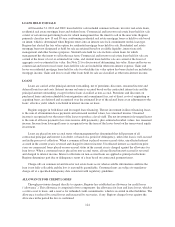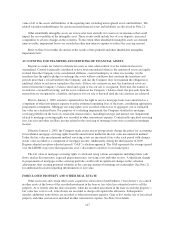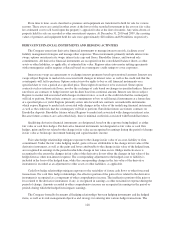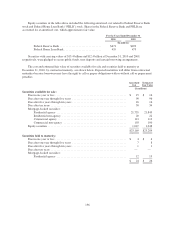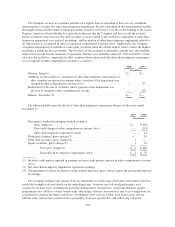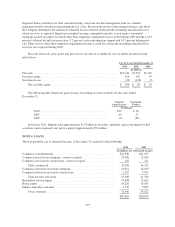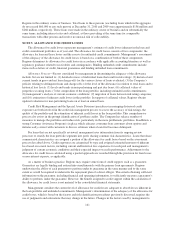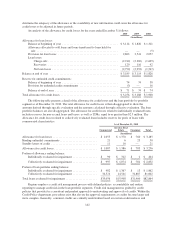Regions Bank 2010 Annual Report Download - page 147
Download and view the complete annual report
Please find page 147 of the 2010 Regions Bank annual report below. You can navigate through the pages in the report by either clicking on the pages listed below, or by using the keyword search tool below to find specific information within the annual report.In February 2010, the FASB issued updated guidance which defers, for certain investment funds, the
consolidation requirements as a result of updated consolidation guidance. Specifically, the deferral is applicable
for a reporting entity’s interest in an entity (1) that has all the attributes of an investment company or (2) for
which it is industry practice to apply measurement principles for financial reporting purposes that are consistent
with those followed by investment companies. This guidance is effective for periods beginning after
November 15, 2009. Regions adopted its provisions during the first quarter of 2010. The adoption of this
guidance did not have a material impact to the consolidated financial statements.
In February 2010, the FASB issued accounting guidance related to the consolidation of certain investment
funds deferring, for those certain investment funds, the consolidation requirements that had resulted from
guidance previously issued. Specifically, the deferral is applicable for a reporting entity’s interest in an entity
(1) that has all the attributes of an investment company or (2) for which it is industry practice to apply
measurement principles for financial reporting purposes that are consistent with those followed by investment
companies. This guidance is effective for periods beginning after November 15, 2009. Regions adopted its
provisions during the first quarter of 2010. The adoption of this guidance did not have a material impact to the
consolidated financial statements.
In March 2010, the FASB issued accounting guidance relating to the scope exception related to embedded
credit derivatives amending and clarifying the accounting for credit derivatives embedded in interests in
securitized financial assets. This guidance is effective for interim periods beginning after June 15, 2010 and its
adoption did not have a material impact to the consolidated financial statements.
In July 2010, the FASB issued accounting guidance related to disclosures about the credit quality of
financing receivables and the allowance for credit losses. The amended guidance applies to all financing
receivables except for short-term trade receivables and receivables measured at either fair value or the lower of
cost or fair value. The objective of the amendment is disclosure of information that enables financial statement
users to understand the nature of inherent credit risks, the entity’s method of analysis and assessment of credit
risk in estimating the allowance for credit losses, and the reasons for changes in both the receivables and
allowances when examining a creditor’s portfolio of financing receivables and its allowance for losses. Under the
new guidance, the disaggregation of financing receivables will be disclosed by portfolio segment or by class of
financing receivable. The amended guidance is applicable to period-end balances beginning with the first interim
or annual reporting period ending on or after December 15, 2010. Regions adopted this guidance as of
December 31, 2010 for the disclosures related to end of period financial reporting. See Note 5 for additional
information regarding the allowance for credit losses.
FUTURE APPLICATION OF ACCOUNTING STANDARDS
In October 2010, the FASB issued guidance addressing the diversity in practice regarding which costs
related to the acquisition or renewal of insurance contracts qualify as deferred acquisition costs for insurance
entities. This update amends guidance related to financial services by requiring that costs incurred with the
acquisition and renewal of insurance contracts be capitalized as deferred acquisition costs. Incremental direct
costs, portions of employees’ compensation associated with time spent acquiring contracts, and other costs
directly relating to the advertising, underwriting, issuing and processing of insurance policies are costs that
should be capitalized to the extent that they would not have otherwise been incurred had the contracts not been
successfully acquired. The amended guidance is effective for fiscal years, and for interim periods within those
fiscal years, beginning after December 15, 2011. Early adoption at the beginning of an entity’s fiscal year is
permitted. Regions is in the process of reviewing the potential impact of this guidance; however, its adoption is
not expected to have a material impact to the consolidated financial statements.
In December 2010, the FASB issued guidance for the consideration an entity must give regarding whether it
is more likely than not that goodwill impairment exists for each reporting unit with a zero or negative carrying
amount. As a result, an entity can no longer assert that a reporting unit is not required to perform the second step
133



